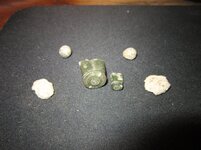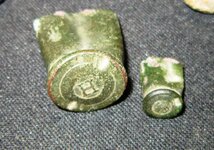- Mar 5, 2010
- 7,598
- 12,169
- Detector(s) used
- XP Deus, White's DFX
- Primary Interest:
- All Treasure Hunting
Hey Y'all,
I had a very meager hunt Sunday morning but did get one interesting shell casing. It is a 44 cal. Henry. What interested me was the four sets of firing pin marks. Three appear to be lighter mis-strikes before the heavy fourth set the shell off. Was this normal for a Henry or could it have been the result of a dirty firing mechanism. I don't think these buleets can be re-loaded can they?
I had a very meager hunt Sunday morning but did get one interesting shell casing. It is a 44 cal. Henry. What interested me was the four sets of firing pin marks. Three appear to be lighter mis-strikes before the heavy fourth set the shell off. Was this normal for a Henry or could it have been the result of a dirty firing mechanism. I don't think these buleets can be re-loaded can they?








